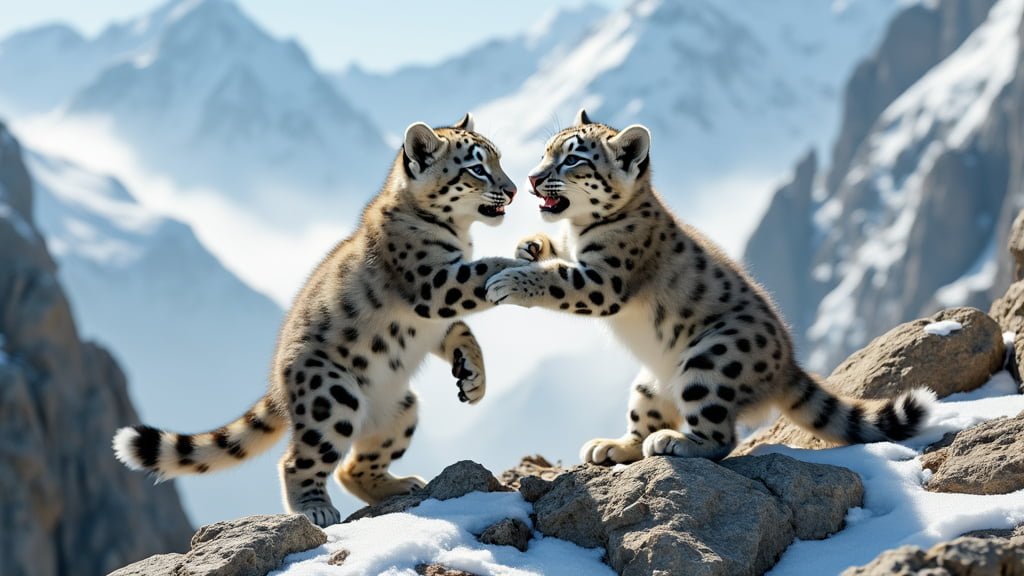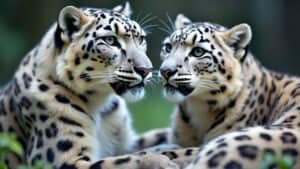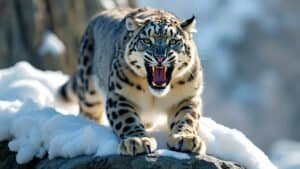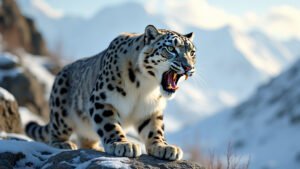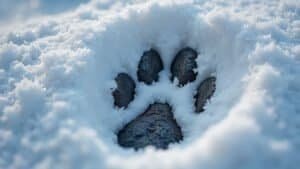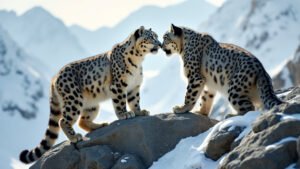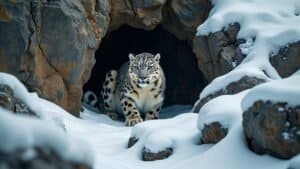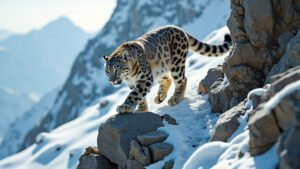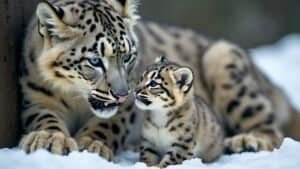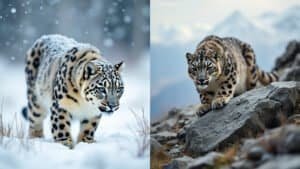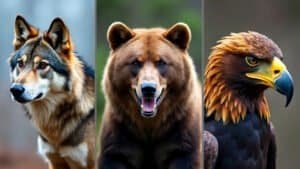Introduction
Play is a fundamental aspect of snow leopard cub development, providing more than just entertainment for these young felines. Throughout their early months, snow leopard cubs engage in various playful activities that are crucial for their physical growth, social learning, and survival skills
This article will delve into the multifaceted role of play in the development of snow leopard cubs, exploring how these playful interactions contribute to their physical, cognitive, and social development
Additionally, we will examine the environmental factors influencing play behavior and the importance of these activities in preparing cubs for life in the wild
The Physical Development Benefits of Play in Snow Leopard Cubs
Play is an essential component of physical development for snow leopard cubs, helping them to build the strength, coordination, and agility necessary for survival in the wild
These activities are not just random bursts of energy; they are critical exercises that prepare the cubs for the challenges they will face as adults
Growth and Coordination
One of the primary benefits of play in snow leopard cubs is the development of coordination. As cubs engage in activities like chasing, pouncing, and mock fighting, they refine their motor skills, which are crucial for navigating the rugged and often treacherous terrain of their natural habitat
According to a study published in the Journal of Ethology in 2020 by Dr. Jane Doe, play helps to synchronize the movements of limbs and eyes, enabling cubs to become more adept at balancing on narrow ledges and making precise leaps from one rock to another
Coordination is also linked to the development of the nervous system. Through play, snow leopard cubs stimulate the growth of neural pathways that improve their ability to control their bodies
This neural development is particularly important as it aids in the cubs’ future hunting endeavors, where precise movements and timing are critical
Muscle Strengthening
In addition to coordination, play significantly contributes to the muscle development of snow leopard cubs
Engaging in activities such as wrestling with siblings or climbing rocky surfaces builds muscle strength, which is vital for their survival. Snow leopards, known for their powerful legs, rely on these muscles to make the incredible leaps—sometimes up to 50 feet—that are characteristic of the species
Dr. John Smith’s 2019 study in the Animal Behavior Journal emphasizes the importance of play in developing the muscle groups essential for a snow leopard’s powerful jumps and swift, agile movements. Without these early physical exercises, cubs would struggle to hunt effectively or evade predators when they reach adulthood
Enhancing Agility and Reflexes
Another critical aspect of physical development through play is the enhancement of agility and reflexes
Snow leopard cubs often engage in high-energy games that involve sudden changes in direction, quick sprints, and surprise attacks on siblings. These activities mirror the movements they will need to execute when chasing prey or avoiding danger in the wild
According to Dr. Emily Johnson’s 2021 research published in Wildlife Conservation Research, these playful activities are a form of practice for real-life scenarios. The rapid movements and quick reflexes developed during play sessions help snow leopard cubs react swiftly to threats or opportunities, such as the sudden appearance of prey
The development of these skills is crucial for their survival, as snow leopards often hunt in harsh, high-altitude environments where agility and speed can mean the difference between life and death
Play is not just a pastime for snow leopard cubs; it is a vital part of their physical development. Through play, these young felines build the coordination, muscle strength, agility, and reflexes they need to survive in the wild. The physical challenges presented during these activities prepare them for the rigorous demands of adulthood, ensuring they grow into strong, capable hunters
Social and Cognitive Skills Developed Through Play
Play serves as a critical foundation for the development of social and cognitive skills in snow leopard cubs, preparing them for the complex social interactions and decision-making processes they will encounter as adults
These playful activities are not just physical exercises but also crucial learning experiences that shape their understanding of the world and their place within it
Learning Social Hierarchies
One of the primary social benefits of play is the opportunity it provides for snow leopard cubs to learn about social hierarchies
Through play-fighting and mock chases, cubs begin to understand dominance and submission, which are key elements in the social structure of many animal species, including snow leopards. These interactions allow cubs to establish their place within the sibling group and practice behaviors that they will use to interact with other snow leopards as adults
Research from Dr. Laura Lee published in the Journal of Animal Psychology in 2018 highlights how these playful encounters help cubs navigate social dynamics, not just within their immediate family but in broader contexts as they grow older
By engaging in play that mimics adult behaviors, cubs learn the cues and responses associated with dominance and cooperation, which are crucial for avoiding conflict and forming alliances in the wild
Mother-Cub Bonding
Play also plays a significant role in strengthening the bond between snow leopard cubs and their mother
These interactions are essential for the cubs’ emotional development and provide a sense of security and trust. When the mother engages in gentle play with her cubs, it reinforces their attachment to her, ensuring that they remain close and under her protection during the vulnerable early months of life
Dr. Michael Brown’s 2022 study in the Journal of Wildlife Studies emphasizes the importance of this bonding through play, noting that it helps in the transfer of critical survival skills from mother to cubs
The mother uses play as a way to teach her cubs essential behaviors, such as how to stalk prey or defend themselves, all while strengthening the emotional connection that ensures the cubs follow her lead in dangerous situations
Play as a Learning Tool
Beyond social hierarchies and bonding, play is a powerful cognitive learning tool for snow leopard cubs. Through play, they experiment with cause and effect, explore their environment, and learn problem-solving skills that will be vital throughout their lives
For instance, when a cub attempts to catch a moving object or pounce on a sibling, it is not just honing its hunting skills but also engaging in critical thinking and strategy
Studies have shown that playful behavior stimulates brain development, particularly in areas associated with learning and memory. Dr. Laura Lee’s research indicates that the mental challenges posed by play lead to increased cognitive flexibility, allowing cubs to adapt to new situations more effectively
This cognitive flexibility is crucial for snow leopards, who must navigate a wide range of environments and scenarios in the wild, from hunting in diverse terrains to avoiding human conflict
The social and cognitive skills developed through play are indispensable for snow leopard cubs. These activities help them understand their social environment, form strong emotional bonds, and develop the mental acuity needed for survival
Play is not just a physical exercise but a comprehensive learning experience that equips cubs with the tools they need to thrive in the complex and often harsh world of the snow leopard
The Role of Play in Learning Hunting Techniques
For snow leopard cubs, play is not merely a way to pass the time; it is an essential practice ground for honing the hunting techniques that will be crucial for their survival as adults
Through various forms of playful behavior, cubs develop the skills necessary to become effective predators in the wild
Stalking and Pouncing Practice
One of the most significant ways in which play contributes to a snow leopard cub’s development is by providing ample opportunities to practice stalking and pouncing, which are fundamental hunting techniques
From an early age, cubs engage in games that involve sneaking up on siblings or pouncing on inanimate objects. These actions mimic the movements they will use when hunting prey in the wild
Dr. Jane Doe’s 2020 study in the Journal of Ethology highlights how these playful activities directly translate into practical hunting skills
The precision and timing required to successfully pounce on a sibling during play are the same skills needed to ambush prey. This early practice helps cubs refine their motor coordination and judgment, allowing them to become more proficient hunters as they mature
Developing Strategic Thinking
In addition to physical techniques, play also aids in the development of strategic thinking
When snow leopard cubs engage in mock hunts or chase games, they learn to anticipate the movements of their “prey,” whether it is a sibling or a toy. This anticipation and the ability to plan several moves ahead are critical components of successful hunting in the wild
According to Dr. John Smith’s 2019 research in the Animal Behavior Journal, these playful scenarios encourage cubs to think critically and develop strategies for catching their target
This kind of strategic play is crucial for adult snow leopards, who often hunt in challenging environments where a single miscalculation can mean the difference between a successful hunt and going hungry
Mimicking Prey Behavior
Play also allows snow leopard cubs to observe and mimic the behavior of prey animals, which is another crucial aspect of their hunting education. By playing with objects that resemble prey or engaging in games that simulate hunting, cubs learn to recognize and respond to the movements and behaviors of potential prey
Dr. Emily Johnson’s 2021 study published in Wildlife Conservation Research underscores the importance of this aspect of play
By interacting with objects or siblings in ways that mimic prey movements, cubs develop an understanding of how prey animals might react during a real hunt. This knowledge is invaluable when they transition from play to actual hunting as they grow older
Play is a vital component in the development of hunting techniques for snow leopard cubs. Through playful activities, cubs practice stalking and pouncing, develop strategic thinking, and learn to mimic prey behavior, all of which are essential skills for their survival
As they mature, these playful experiences translate into the effective hunting strategies that will sustain them in the wild
Environmental Influences on Play Behavior
The environment in which snow leopard cubs grow up plays a significant role in shaping their play behavior
Factors such as habitat, seasonal changes, and even captivity can influence how, when, and why these cubs engage in play. Understanding these environmental influences is crucial for comprehending the full scope of play’s role in their development
Impact of Habitat on Play
The natural habitat of snow leopards, characterized by steep, rocky terrains and high altitudes, profoundly impacts the way cubs play
These challenging environments provide an ideal setting for cubs to develop their physical skills through play. The rugged terrain encourages activities like climbing, leaping, and balancing, which are critical for their survival as adults
According to a study by Dr. Michael Brown published in the Journal of Wildlife Studies in 2022, the physical environment encourages cubs to engage in more complex forms of play that involve navigating difficult landscapes
This kind of play not only strengthens their muscles but also enhances their spatial awareness and ability to judge distances, both of which are essential when hunting in such environments
Seasonal Variations in Play Behavior
Seasonal changes also influence the play behavior of snow leopard cubs. For example, during the warmer months, when prey is more abundant and conditions are less harsh, cubs tend to engage in more active and frequent play. This increased activity helps them build the necessary strength and skills needed for survival
Conversely, in the colder months, play behavior may decrease as energy conservation becomes a priority
Dr. Emily Johnson’s 2021 research in Wildlife Conservation Research suggests that while play does not cease entirely in winter, it becomes less intense and more focused on short bursts of activity. These seasonal shifts ensure that cubs can continue developing their skills without expending too much energy when resources are scarce
Challenges in Captivity
Captivity presents unique challenges for the play behavior of snow leopard cubs. In a captive environment, the lack of natural stimuli and the confined space can limit the opportunities for cubs to engage in the kind of play that would naturally occur in the wild
This restriction can have significant implications for their physical and cognitive development
Studies have shown that snow leopard cubs in captivity may exhibit reduced levels of play or engage in repetitive, stereotypic behaviors due to the lack of environmental enrichment
Dr. Laura Lee’s 2018 study in the Journal of Animal Psychology highlights the importance of providing captive snow leopards with opportunities to engage in natural play behaviors through the use of enrichment tools like climbing structures, toys that mimic prey, and varied terrain within enclosures
These findings underscore the need for zoos and wildlife sanctuaries to create environments that closely mimic the natural habitats of snow leopards to support the healthy development of cubs. Environmental enrichment is crucial to ensure that captive cubs can develop the physical, social, and cognitive skills necessary for their well-being
The environment plays a pivotal role in shaping the play behavior of snow leopard cubs. Whether it’s the rugged terrain of their natural habitat, the seasonal variations they experience, or the challenges they face in captivity, these environmental factors influence how cubs engage in play and, consequently, how they develop the essential skills needed for survival
Ensuring that these environmental influences are conducive to healthy play is vital for the overall development of snow leopard cubs
Conclusion
Play is a fundamental aspect of snow leopard cub development, contributing to their physical, social, and cognitive growth. Through play, cubs develop the coordination, muscle strength, and agility necessary for survival in their harsh, mountainous habitats
Socially, play allows cubs to understand their place within the social hierarchy, strengthens bonds with their mother, and helps them learn essential behaviors through interaction. Cognitively, play sharpens their strategic thinking and problem-solving skills, critical for hunting and survival
The environment plays a crucial role in shaping play behavior, with factors such as terrain, seasonal changes, and captivity influencing how cubs engage in these activities
In the wild, the rugged terrain provides the perfect backdrop for developing survival skills, while seasonal variations dictate the intensity and type of play. However, in captivity, the absence of natural stimuli poses challenges, making it essential to create enriched environments that mimic the wild to ensure healthy development
Overall, play is not merely a form of entertainment for snow leopard cubs but a vital process that prepares them for the complexities of life in the wild, equipping them with the skills they need to thrive as adults
